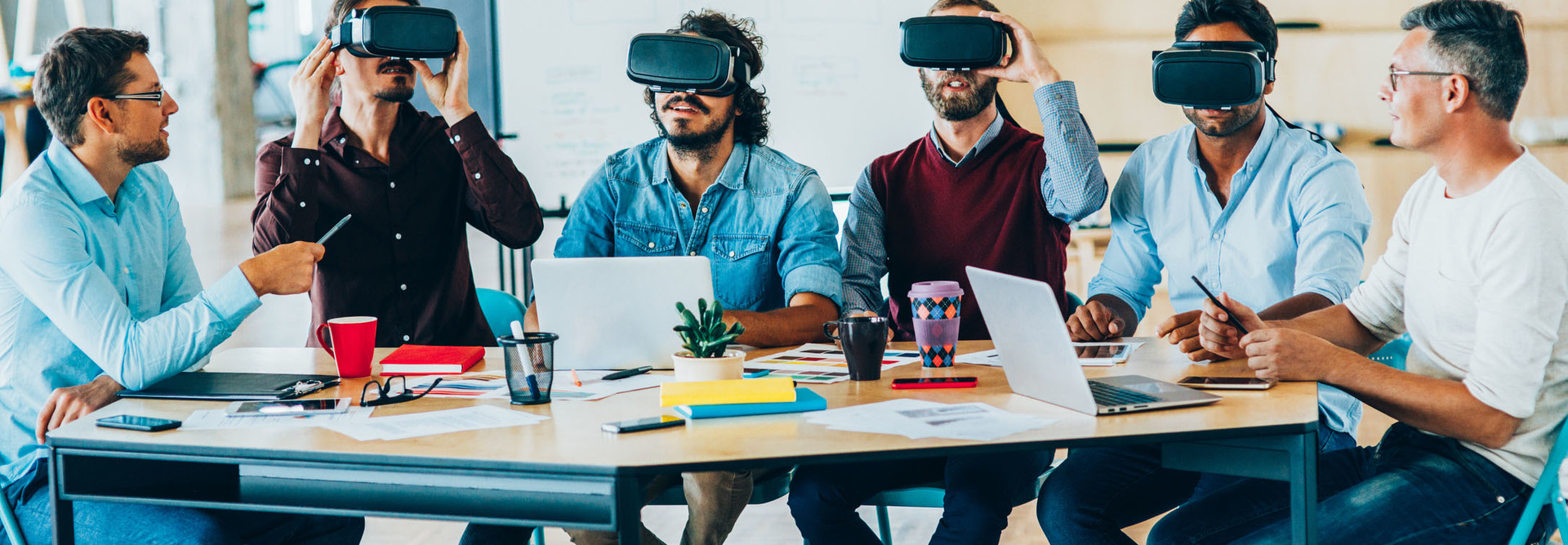Virtual Reality: Coming to an Industry Near You
Virtual reality technology entered the public eye in the early 1990s, when VR goggles were integrated into arcade machines, allowing users to immerse themselves in stereoscopic 3D visuals and connect to one another in multiplayer games. Years later, the technology was popularized via consumer gaming headsets, which gamers could use to create the same immersive experiences on their home consoles.
Little did we know these were the humble beginnings of what is now a multibillion-dollar market, one that has not just changed how we play, but also how we work.
Today, VR has expanded beyond its gaming origins and is no longer just a niche, recreational technology. VR is a technological innovation driven by strong market insights and financial impact, and has tremendous potential to disrupt some of the most unexpected industries. Goldman Sachs reports commercial spending for virtual reality will overtake consumer spending by 2020 and grow to a projected $80 billion market (combined with augmented reality) by 2025.
The rapid development of technology is also spurring its adoption and commercialization in the business and industrial sectors. Higher visual fidelity helmet-mounted displays and better integrated solutions — along with an increasing comfort level among users — are accelerating the adoption of VR in innovative ways for unexpected industries. The possibilities are endless and attractive to the future world at work, with a forecast of 171 million active virtual reality users by the end of this year.
MORE FROM BIZTECH: Sports teams gain an edge through VR and drones.
VR Augments Design, Prototyping and Collaboration Capabilities
Since the origins of modern architecture and design, creating scaled-down physical models has been an important part of how architects prototype buildings, infrastructure and vehicles in 3D space. While effective, this method has not always allowed architects, designers and urban planners to move as quickly as their imaginations. Today, virtual reality supports more efficient and inclusive design review, rapid and more accurate prototyping, and the creation of more engaging customer presentations.
Take automobile engineering, for example. Cars are typically designed using digital drawings, which are then developed into full-scale clay models. This artistic process has been a staple of the automobile industry for decades. However, building a model at scale requires multiple sculptors and can take months to complete. VR enables a new way of prototyping for automobiles that allows designers to create, view and interact with a full-sized version of any of their models.
The American automaker Ford uses VR headsets for designing and manufacturing its cars to spur faster prototyping and design review of new models. The Ford Immersive Vehicle Environment (FiVE) feeds computer-aided design data into a VR technology. The user can step inside the car, sit in the driver’s seat and even examine the exterior and underside of the virtual vehicle. Other team members can watch on screen to see exactly what the driver is seeing, an experience that feels very similar to being in the car themselves.
Another virtual technology, called CAVE, is used by military hardware producer Raytheon in its manufacturing process. CAVE is a product-simulation chamber and immersive VR environment that projects computer-generated images onto the walls and ceiling of a room. These immersive design centers allow products to be viewed at every point in the manufacturing process. Employees, even those who might not know how to read or analyze technical drawings, use the IDCs to take an active role in reviewing models and simulation results to streamline manufacturing and communication across the supply chain. These multiuser VR solutions let design teams quickly assemble from wherever they are in the world without the cost and time required to travel, eliminating geographic barriers and making collaboration manageable anytime, anywhere.
Given the rapid pace of global urbanization, which is creating more congested cities, VR solutions will become increasingly vital for designers and city planners who are building smarter, more efficient urban centers.
Virtual Reality Ushers in an Era of Immersive Entertainment
While VR has moved beyond games, it continues to expand our definition of what it means to have fun.
Returning to its recreational roots, VR has the potential to continue transforming the entertainment industry in exciting new ways. For instance, a team at DreamWorks Animation’s DreamLab has created a VR journey for fans of the movie “How to Train Your Dragon.” Just as in the movie, the simulation allows users to take the reins of Toothless the Dragon and soar over the imaginary island of Berk, experiencing the exhilarating physical sensations — the speed, the dips, the peaks — of unfettered flight on the back of an imaginary beast.
Other uses of VR in entertainment include the increasingly popular cultural craze of escape rooms. VR takes all the fun of the physical adventure game and elevates it to a new level with a more immersive and interactive technological experience. For example, Escape VR offers adventures in which participants can solve puzzles and fly through outer space in zero gravity. They can even connect with a group of friends, family members or coworkers during the experience.
VR is also changing the way we interact with one another. In social media, it takes sharing to new heights by enabling users to have more engaging experiences. Periscape, for example, offers VR Experience Centers in airports, which provide travelers with an immersive and dynamic escape from the stressful, mundane and anxiety-ridden reality of ab overcrowded airport and extended hours of wait time. The centers allow users to travel to exotic destinations, draw and create in 3D, personify a musician in a famous rock band and play live action games.
The promise of virtual reality makes it a powerful go-to technology across a wide range of industries. Greater flexibility and reach, improved training, lower cost and a more realistic experience are creating new opportunities and driving the adoption of VR in commercial markets. No longer just a novelty, virtual reality might soon show up in your industry.









